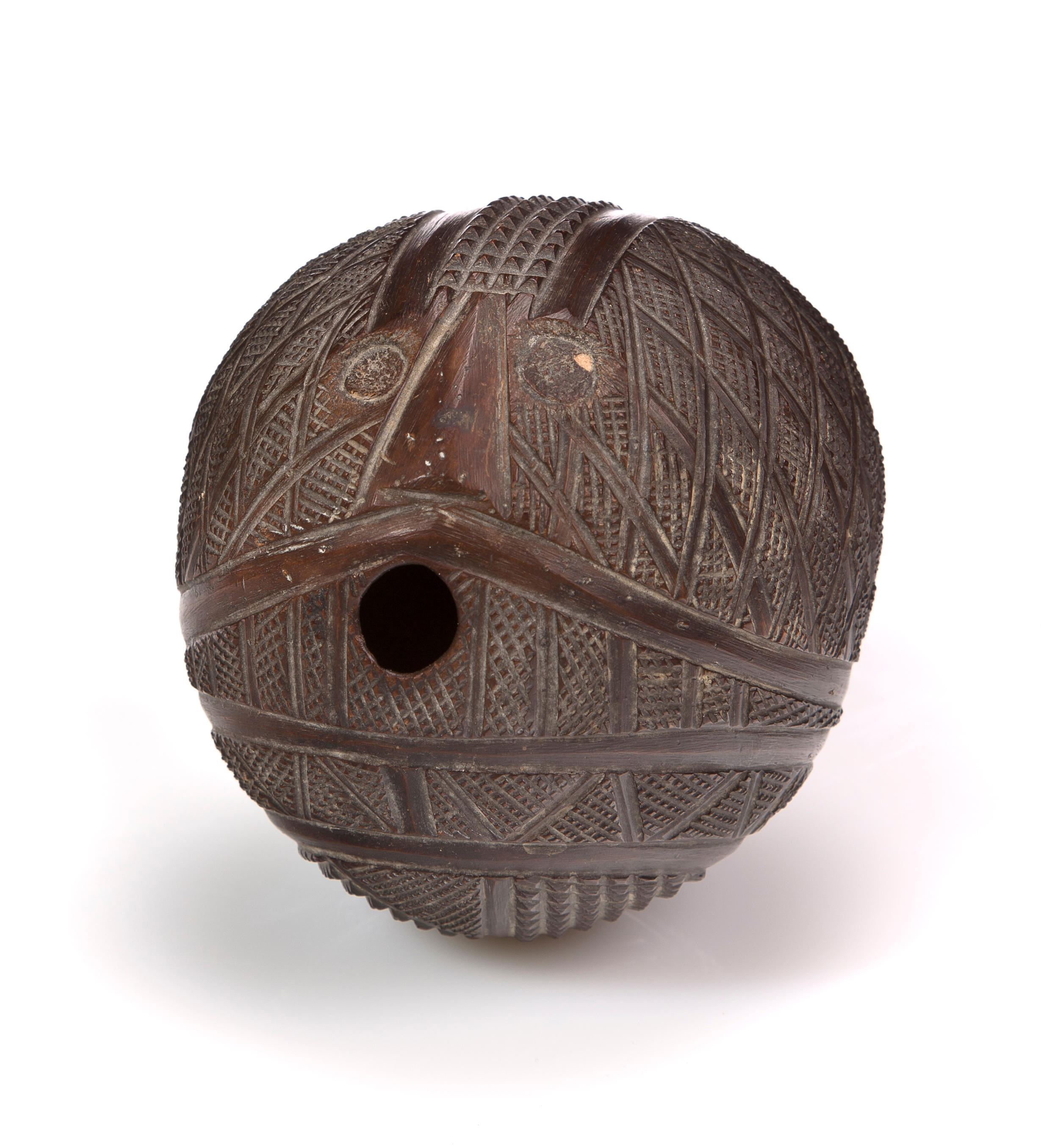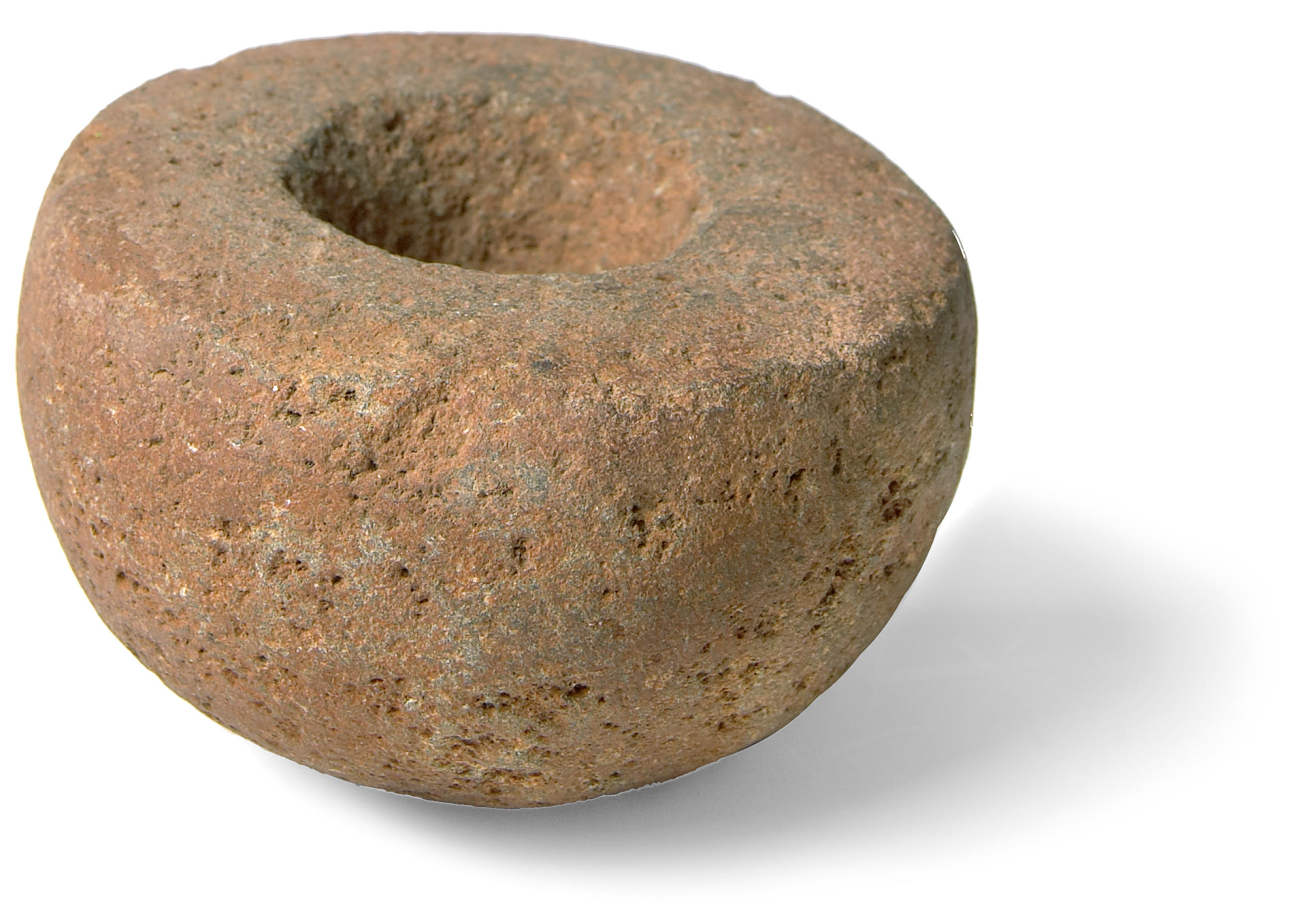height 25in (63.5cm) of hollow ceramic with a red-orange painted body, light buff painted head and the details of the necklace and waistband painted in light buff. Provenance: Cheng-Ley Collection (aquired in the 1960's) NAYARIT, LAGUNILLAS (CHINESCO) TYPE A STYLE KNEELING/SEATED NUDE FEMALE FIGURE The seated nude female is depicted resting on her calves with her buttock nested on the soles of her feet. The feet actually turn in almost at a ninety-degree angle at the ankles with the incised toes facing. Her posture is erect but leaning slightly forward with a natural curve to the spine, and the head is balanced and posed so that the gaze is directly forward. Her hands rest on her abdomen and frame a depressed navel. The only elaboration of the figure is a multi-layered beaded choker necklace and a thin slightly restrictive belt encircling the torso below the navel. The posture is striking in its formality and with its emphasis on the face, breasts, abdomen, and pubis. The scale of this figure in the ceramic medium may easily be designated as monumental and is a quintessential example of Hasso Von Winning's Type A classification of what he termed Chinesco (Chinese-like) style that later scholars changed to Lagunillas to better reflect the geographic origin of the style. Characteristic of the style is a relatively high degree of naturalism although the arms conform to a universal Nayarit rendering of being relatively thin and rather boneless looking. Postures have a quiet majestic sensibility that is often reflected in the modeling of the face. Emotion is not demonstrative but rather implied in subtitles of facial features and expressions. The subject of this sculpture appears to be serenely confident and self aware. Although this ceramic female figure has certain unique qualities she is one of at least three sculptures that are nearly identical and were undoubtedly created by the same artist. This in itself is quite rare especially for ceramics of such antiquity. The other two figures are located in the collection of the Los Angeles County Museum of Fine Arts – part of the Proctor Stafford collection and the other is in the collection of the National Museum of Anthropology in Mexico City. The three sculptures range in scale from 24" to 27 ½" and are identical except for slight differences in details of ornamentation and face painting. This sculpture is also nearly identical in posture and facial expression to another Nayarit, Lagunillas Type A style ceramic sculpture that is by a different artist as seen in the treatment of the arms and slightly different proportions of body parts. A Nayarit nude female effigy in the San Sebastián Red type from the Proctor Stafford collection is also represented in this same-seated posture with hands resting on the belly. This would suggest that these sculptures represent a type of feminine image important to Nayarit social and ideological concepts. The three sculptures that include this one that were made by the same artist were likely not made as a set for one individual. Like the majority of West Mexican ceramic sculptures that have survived to modern times, these likely originated from shaft tombs and accompanied deceased individuals during a last rite of passage. Shaft tombs were mausoleum-like in that it is thought they contain the remains of multiple family members and possibly extended families. The archaeologists Robert B. Pickering and Maria Teresa Cabrero have determined that ceramic female effigies were placed with females and ceramic male effigies were placed with males and in many instances sets on same sexed figurines of different postures and attire accompanied an individual and "...represent different important episodes of and individual's life." The archaeologists also conclude from the similarities of the forms of the sculptural sets that they were created about the time of death. If their assumptions are true, one masterful ceramic artist created the three monumental seated
height 25in (63.5cm) of hollow ceramic with a red-orange painted body, light buff painted head and the details of the necklace and waistband painted in light buff. Provenance: Cheng-Ley Collection (aquired in the 1960's) NAYARIT, LAGUNILLAS (CHINESCO) TYPE A STYLE KNEELING/SEATED NUDE FEMALE FIGURE The seated nude female is depicted resting on her calves with her buttock nested on the soles of her feet. The feet actually turn in almost at a ninety-degree angle at the ankles with the incised toes facing. Her posture is erect but leaning slightly forward with a natural curve to the spine, and the head is balanced and posed so that the gaze is directly forward. Her hands rest on her abdomen and frame a depressed navel. The only elaboration of the figure is a multi-layered beaded choker necklace and a thin slightly restrictive belt encircling the torso below the navel. The posture is striking in its formality and with its emphasis on the face, breasts, abdomen, and pubis. The scale of this figure in the ceramic medium may easily be designated as monumental and is a quintessential example of Hasso Von Winning's Type A classification of what he termed Chinesco (Chinese-like) style that later scholars changed to Lagunillas to better reflect the geographic origin of the style. Characteristic of the style is a relatively high degree of naturalism although the arms conform to a universal Nayarit rendering of being relatively thin and rather boneless looking. Postures have a quiet majestic sensibility that is often reflected in the modeling of the face. Emotion is not demonstrative but rather implied in subtitles of facial features and expressions. The subject of this sculpture appears to be serenely confident and self aware. Although this ceramic female figure has certain unique qualities she is one of at least three sculptures that are nearly identical and were undoubtedly created by the same artist. This in itself is quite rare especially for ceramics of such antiquity. The other two figures are located in the collection of the Los Angeles County Museum of Fine Arts – part of the Proctor Stafford collection and the other is in the collection of the National Museum of Anthropology in Mexico City. The three sculptures range in scale from 24" to 27 ½" and are identical except for slight differences in details of ornamentation and face painting. This sculpture is also nearly identical in posture and facial expression to another Nayarit, Lagunillas Type A style ceramic sculpture that is by a different artist as seen in the treatment of the arms and slightly different proportions of body parts. A Nayarit nude female effigy in the San Sebastián Red type from the Proctor Stafford collection is also represented in this same-seated posture with hands resting on the belly. This would suggest that these sculptures represent a type of feminine image important to Nayarit social and ideological concepts. The three sculptures that include this one that were made by the same artist were likely not made as a set for one individual. Like the majority of West Mexican ceramic sculptures that have survived to modern times, these likely originated from shaft tombs and accompanied deceased individuals during a last rite of passage. Shaft tombs were mausoleum-like in that it is thought they contain the remains of multiple family members and possibly extended families. The archaeologists Robert B. Pickering and Maria Teresa Cabrero have determined that ceramic female effigies were placed with females and ceramic male effigies were placed with males and in many instances sets on same sexed figurines of different postures and attire accompanied an individual and "...represent different important episodes of and individual's life." The archaeologists also conclude from the similarities of the forms of the sculptural sets that they were created about the time of death. If their assumptions are true, one masterful ceramic artist created the three monumental seated















Testen Sie LotSearch und seine Premium-Features 7 Tage - ohne Kosten!
Lassen Sie sich automatisch über neue Objekte in kommenden Auktionen benachrichtigen.
Suchauftrag anlegen